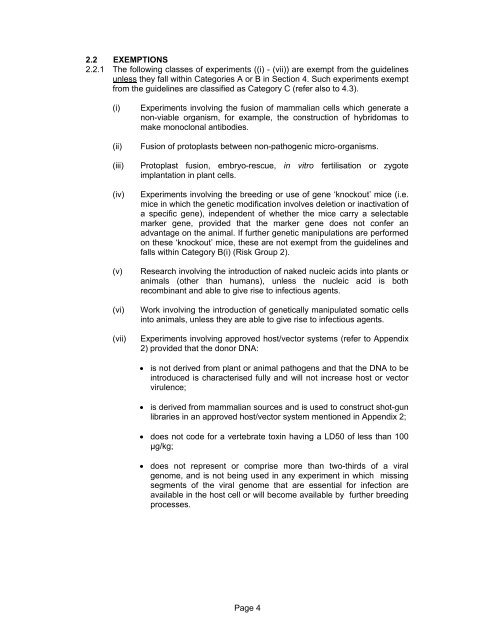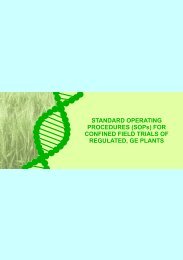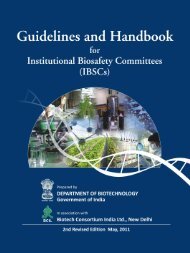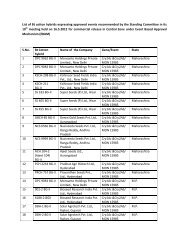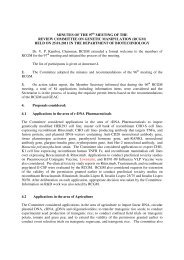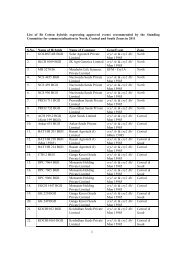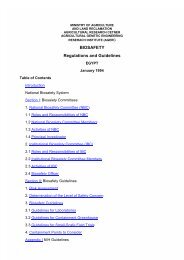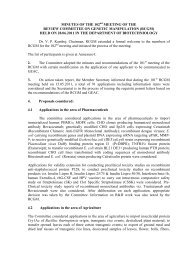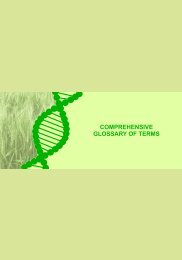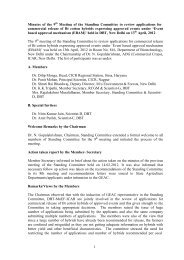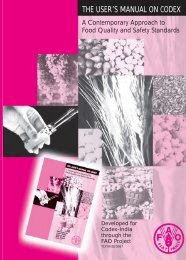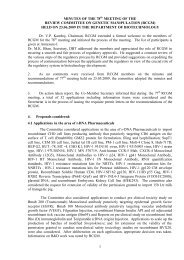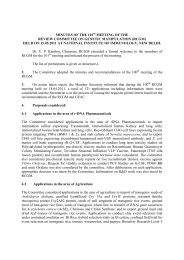Biosafety Guidelines For Research On Genetically Modified ...
Biosafety Guidelines For Research On Genetically Modified ...
Biosafety Guidelines For Research On Genetically Modified ...
Create successful ePaper yourself
Turn your PDF publications into a flip-book with our unique Google optimized e-Paper software.
2.2 EXEMPTIONS<br />
2.2.1 The following classes of experiments ((i) - (vii)) are exempt from the guidelines<br />
unless they fall within Categories A or B in Section 4. Such experiments exempt<br />
from the guidelines are classified as Category C (refer also to 4.3).<br />
(i)<br />
(ii)<br />
(iii)<br />
(iv)<br />
(v)<br />
(vi)<br />
(vii)<br />
Experiments involving the fusion of mammalian cells which generate a<br />
non-viable organism, for example, the construction of hybridomas to<br />
make monoclonal antibodies.<br />
Fusion of protoplasts between non-pathogenic micro-organisms.<br />
Protoplast fusion, embryo-rescue, in vitro fertilisation or zygote<br />
implantation in plant cells.<br />
Experiments involving the breeding or use of gene ‘knockout’ mice (i.e.<br />
mice in which the genetic modification involves deletion or inactivation of<br />
a specific gene), independent of whether the mice carry a selectable<br />
marker gene, provided that the marker gene does not confer an<br />
advantage on the animal. If further genetic manipulations are performed<br />
on these ‘knockout’ mice, these are not exempt from the guidelines and<br />
falls within Category B(i) (Risk Group 2).<br />
<strong>Research</strong> involving the introduction of naked nucleic acids into plants or<br />
animals (other than humans), unless the nucleic acid is both<br />
recombinant and able to give rise to infectious agents.<br />
Work involving the introduction of genetically manipulated somatic cells<br />
into animals, unless they are able to give rise to infectious agents.<br />
Experiments involving approved host/vector systems (refer to Appendix<br />
2) provided that the donor DNA:<br />
• is not derived from plant or animal pathogens and that the DNA to be<br />
introduced is characterised fully and will not increase host or vector<br />
virulence;<br />
• is derived from mammalian sources and is used to construct shot-gun<br />
libraries in an approved host/vector system mentioned in Appendix 2;<br />
• does not code for a vertebrate toxin having a LD50 of less than 100<br />
µg/kg;<br />
• does not represent or comprise more than two-thirds of a viral<br />
genome, and is not being used in any experiment in which missing<br />
segments of the viral genome that are essential for infection are<br />
available in the host cell or will become available by further breeding<br />
processes.<br />
Page 4


